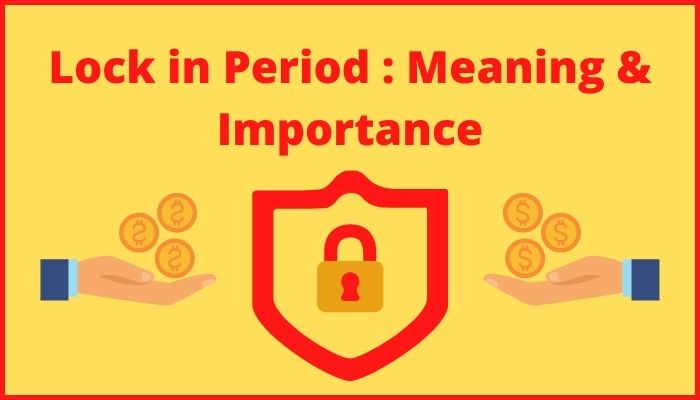Hedge funds, private equity IPOs, startups, and a small number of mutual funds all have lock-in periods. The sole open ended mutual funds with a lock-in term are ELSS funds (tax saver funds). Let’s discuss lock in Period Meaning in detail, as well as why it’s essential and what to do once it’s over.
Table of Contents
lock in Period Meaning
The period of time in which an investor is unable to reclaim or sell his/her holding is known as the lock in period. Investors are unable to sell their assets throughout this period. Nevertheless, Investors are free to sell their holdings once the period has ended.
Lock in Period Meaning in IPO (Initial Public Offering)

When a private equity company issues its first public stock, lock-in periods are common for Qualified Institutional Buyer and Promoters. The ability of Promoters & Qualified Institutional Buyer to sell their shares immediately after an IPO is prohibited.
Lock in Period Meaning in Hedge Funds and Startups
The lock-in period is also used by hedge funds and startups. It is used by hedge funds to keep their portfolios stable. Startups, on the other hand, use it to keep capital on hand.
Lock in Period Meaning in Mutual Funds
Mutual fund investments often have a lock-in period. A lock-in duration applies to all closed-end mutual funds. There is no lock-in period for open-ended mutual funds. There is just a special case: Equity Linked Savings Scheme (ELSS) funds have a three-year lock-in period.
In other terms, investors will not be able to sell their holdings throughout this time. Investors can look to continue investing in the fund for as much as it continues after this term ends, or liquidate their mutual fund holdings.
There is no lock-in period with an open ended mutual fund. Therefore, if the investors leave within a year, they will be levied an exit fee.
Lock in period in Equity Mutual Fund’s
The Equity Linked Savings Scheme is the only kind of equity mutual fund with the period. The lock-in period for an Equity Linked Savings Scheme (ELSS) is three years. Investments in ELSS funds are tax-exempt per Section 80C of the Income Tax Act.
The income tax relief maximum is INR 1,50,000. ELSS fund returns, on the other hand, are taxable. If the holding duration is less than one year, they are subject to a 15% Short Term Capital Gains Tax (STCG).
Long Term Capital Gains Tax (LTCG) of 10% on capital gains exceeding INR 1,00,000 if held for more than one year. Debt Funds and Hybrid Funds don’t have any lock in Period.

Lock in period of other tax saving schemes
They are eligible for a tax break under Section 80C of the Internal Revenue Code. Tax Saving FDs, PPFs, NPSs, and NSCs are a few more tax-saving investments with a lock-in period.
PPF
One of the most popular investing schemes is the Public Provident Fund (PPF). The Public Provident Fund is backed by the Indian government. This plan is a fantastic choice for retirement planning as well as tax savings. The Public Provident Fund, on the other hand, has a 15-year lock-in term.
In addition, this is a low-risk investment. PPF has a guaranteed rate of return. 7.10 percent is the current interest rate. As a result, the strategy is appropriate for investors who want to take a low-risk approach. It’s also perfect for investors looking for a steady stream of income.
In addition, the system provides tax advantages. PPF investments up to INR 1,50,000 per year, in other terms, are tax-free under Section 80C of the Income Tax Act.
NSP
The National Pension Scheme is a pension plan that also includes an investment component. It’s also a self-directed retirement plan. The NPS has the support of the Indian government. NPS funds are spread throughout a variety of asset classes, including stock and debt. The investor has the choice of selecting the type of investment that they want to make.
The investments in the NPS are market-linked. As a result, they cannot guarantee refunds. The NSP has a lock-in term that lasts until the investor turns 60. The plan encourages participants to put money aside for retirement.
Investors can reclaim up to INR 1,50,000 under Section 80C. In addition, they can reclaim INR 50,000 via Section 80CCD.
NSC
Small and medium-sized deposits are encouraged by the National Savings Certificate (NSC). The National Savings Certificate (NSC) is a fixed-income plan. The initiative has the support of the Indian government. As a result, the danger is modest.
As a result, NSC is well suited to small investors seeking assured returns on little investments. NSC requires a minimum investment of INR 100 and has no upper limit. Investments up to INR 1,50,000 per year, on the other hand, are tax-free under Section 80C of the Income Tax Act.
In addition, no TDS is applied to NSC investment dividends. The returns, on the other hand, are taxable at the investor’s income tax rate.
Options after the Period is over
Investors should not immediately reclaim their investments after the lock-in period has ended. They should evaluate the investment’s performance before deciding whether or not to reclaim it. Investors should evaluate their fund’s profitability.
Elss lock in period
ELSS funds are beneficial in more ways than one. They provide tax savings as well as long-term capital appreciation. ELSS funds are primarily used by investors to reduce their tax liability. They redeem this investment when the three-year lock-in period expires in order to invest in a new ELSS fund.
Reviewing the performance
They do it to save money on taxes. This, nevertheless, limits the rewards to investors. ELSS funds are mutual funds that invest in stocks. They’re simply multi-cap funds with well-diversified portfolios overseen by a seasoned fund manager.
For his services, the fund manager charges a fee. It is recommended that investors stay involved in these funds for at least 5-7 years in order to get the most out of their ELSS investments.
Continue after 3 year or not
Investors in the ELSS fund can reevaluate their asset after three years. Investors must correlate their objectives with the fund’s performance in order to achieve this.
If the fund is expanding and meeting the investor’s financial objectives, the investor should continue to invest in it. Nevertheless, if the fund’s performance falls short of the investor’s expectations, it’s best to cash out and look for a new ELSS fund.
Reclaim
Investors should not rely their investment duration on the length of the lock in period. Investors’ interests, as well as liquidity and fund stability, are served by imposing it. After three years, the lock in period for ELSS funds expires.
Investors are encouraged to only reclaim their investments if they have a genuine need for cash. Redeeming investments is acceptable in the event of medical emergencies or uncertainties.
When you’re approaching a financial goal or the fund’s performance isn’t meeting your expectations, you can redeem your contributions. Otherwise, investors might continue to benefit from equities investment by staying involved.
What is the significance of the lock-in period?
For investors to gain the profits from investing in securities, a this is necessary. The majority of investors are inexperienced and react to minor market swings. It will encourage investors to commit to the investment for a period of time, allowing them to gain the profits of long-term investing.
Mutual fund investments are subject to lock in periods in order to maintain fund stability. Extreme selling may result in a rise in outflows, posing a liquidity problem for the fund.
As a result, the lock-in period will assist in the preservation of liquidity. Investors will be unable to sell their units during the lock-in period, ensuring the fund’s assets remain steady. This is good for all the investors.

Conclusion
A lockup period isn’t simply about preventing you from selling your investments. It also allows investors to increase the value of their investments. The term of an investment is not defined by a lock-in period. It is merely a restriction imposed by the AMC or firm in order to protect liquidity and market stability.
This is all from our side regarding it. Although, if you have any doubts you can just comment below.
Other Interesting blogs related to Lock In Period
SIP Investment is Good or Bad?
Mutual Funds in Demat Account Pros and Cons
How to Invest in Mutual Funds without Demat Account
FAQ About what is lock in period
lock in period meaning in hindi?
एक निवेशक के भीतर अपनी होल्डिंग को पुनः प्राप्त करने या बेचने में असमर्थ होने की अवधि को लॉक-इन अवधि के रूप में जाना जाता है। इस लॉक-इन अवधि के दौरान निवेशक अपनी संपत्ति बेचने में असमर्थ हैं।
which type of mutual fund has lock in period
ELSS funds have a lock-in period
Lock-in period for SIP?
Normal SIP don't have a lock-in period. However, ELSS funds SIP have a lock-in period of 3 years.
sip without lock-in period?
All SIP are without lock in Period except ELSS funds.
Lock in period for ELSS?
There is a 3 Years Lock-in Period for ELSS.

